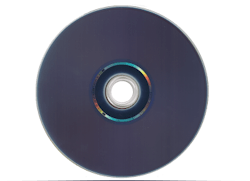Quasirandom nanoimprinting templates (in other words, Blu-Ray discs) increase photovoltaic solar cell light absorption
Blu-ray disk (Cdnomad; Wikipedia)
These days, many types of nanotextured light-trapping surfaces are being designed and tested for use as light-absorbing efficiency enhancers for photovoltaic solar cells. These approaches all share one thing in common in that they are fabricated through some process that involves some form of lithography, nanoimprinting, or nanoparticle self-assembly. However, the optimum pattern is difficult to determine.
Now, researchers at Northwestern University (Evanston, IL) have found that using mass-produced commercial Blu-ray discs (doesn't matter whether they're new or used and unwanted) as nanoimprinting templates produces efficient broadband light absorption.1
The Blu-ray standard for data compression actually leads to a quasirandom arrangement of pits on the manufactured discs, a configuration that naturally leads to a wide-band light-trapping response across the solar spectrum that does not depend on the specific content on the disc (meaning that Dumb and Dumber To will work just as well as Citizenfour or Interstellar).
"We found a random pattern or texture does work better than no pattern, but a Blu-ray disc pattern is best of all," says Jiaxing Huang, one of the researchers. "Then I wondered, why did it work? If you don't understand why, it's not good science."
Huang's wife, Shaorong Liu, a database engineer at IBM, suggested it likely had something to do with data compression. That was the insight Huang needed. The researchers then turned to Northwestern colleague Dongning Guo, an expert in information theory, to investigate this idea. Guo is an associate professor of electrical engineering and computer science.
The researchers looked closely at the data-processing algorithms in the Blu-ray standard and noted the algorithms serve two major purposes: 1) achieving as high a degree of compression as possible by converting the video signals into a seemingly random sequence of 0s and 1s; and 2) increasing error tolerance by adding controlled redundancy into the data sequence, which also limits the number of consecutive 0s and 1s.
These two purposes, the researchers say, have resulted in a quasirandom array of islands and pits (0s and 1s) with feature sizes between 150 and 525 nm, the right range for light-trapping applications over the entire solar spectrum.
21.8% absorption enhancement
The overall broadband absorption enhancement of a Blu-ray patterned solar cell was measured to be 21.8%, the researchers report. "In addition to improving polymer solar cells, our simulation suggests the Blu-ray patterns could be broadly applied for light trapping in other kinds of solar cells," says team member Cheng Sun.
REFERENCE:
1. Alexander J. Smith et al., Nature Communications (2014); doi: 10.1038/ncomms6517
